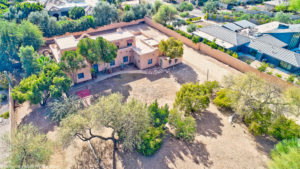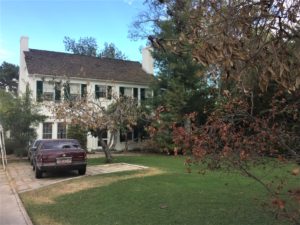Historic Phoenix Architecture Styles In Phoenix, Arizona
Historic Phoenix Architecture in the historic districts and neighborhoods of Arizona don’t only have incredible history with telling pasts, but they also embrace an incredibly wide variety of architectural styles. Below is a breakdown of different styles, their history and photos.
Adobe – Pueblo Revival Architecture in Phoenix, Arizona (1908-present)
SEARCH ALL ADOBE HOMES FOR SALE IN PHOENIX & PHOENIX METRO
Because they’re built with adobe, Pueblo style homes are sometimes called Adobes. Pueblo Revival houses became popular in the early 1900s, mainly in Arizona, California & New Mexico. Inspired by the Pueblo Indians, the historic Phoenix architecture of Adobe’s in Phoenix is pure bliss.
American Colonial Architecture In Phoenix, Arizona (1880-1955)
A true Colonial house is one that was built during North America’s colonial past. Colonial Revival styles emerged in the late 1800’s as a rebellion against elaborate Victorian styles.
Many houses built during the twentieth century can be described as Colonial Revival. Colonial Revival houses have the simplicity and refinement of old Georgian and Federal houses from American history, but. they incorporate modern details.
Art Moderne and Art Deco (1925-1950s)
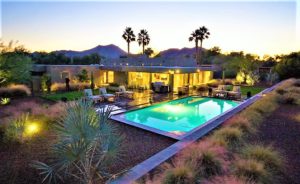 A mix of smooth swirls, curves and high-gloss finishes, art deco style home evokes 1930s movie star glamour. The style was partially inspired by artifacts discovered in 1922 in King Tut’s tomb. Therefore, many art deco buildings include the repeating designs and vivid color common in Egyptian artwork.
A mix of smooth swirls, curves and high-gloss finishes, art deco style home evokes 1930s movie star glamour. The style was partially inspired by artifacts discovered in 1922 in King Tut’s tomb. Therefore, many art deco buildings include the repeating designs and vivid color common in Egyptian artwork.
Phoenix Neighborhoods to Find Art Deco Homes
Although Art Deco homes in Phoenix are not as common as other historic Phoenix architecture styles, there are a few neighborhoods in Central Phoenix where you may occasionally find one. Look in Coronado Historic District, Encanto-Palmcroft, Country Club Manor and Country Club Park.
Bungalow Architecture in Phoenix, Arizona (1880-1930)
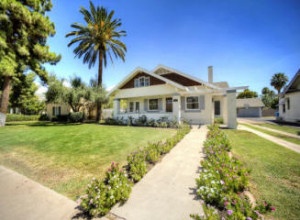 The Bungalow style home showed up in America in the 1880s but it was its development in Southern California that paved the way for its new role as a year-round house. This turned it into the most popular house style American had ever known.
The Bungalow style home showed up in America in the 1880s but it was its development in Southern California that paved the way for its new role as a year-round house. This turned it into the most popular house style American had ever known.
Where Can You Buy a Bungalow In Phoenix, AZ?
There are many historic districts in Phoenix where you can buy a Bungalow. However, the districts which house an abundance are Willo Historic District, Alvarado, Roosevelt, Coronado, Earll Place, Ashland Place and Brentwood, to name just a few.
Cape Cod Architecture in Phoenix, Arizona (1931-1950)
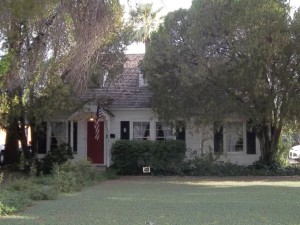 The first Cape Cod style homes were built by English colonists who came to America in the late 17th century. But, after World War II, the architect Royal Barry Wills promoted the Cape Cod style for small homes in suburban developments throughout the USA.
The first Cape Cod style homes were built by English colonists who came to America in the late 17th century. But, after World War II, the architect Royal Barry Wills promoted the Cape Cod style for small homes in suburban developments throughout the USA.
La Hacienda Historic District and Yaple Park neighborhoods in Phoenix have some stunning examples of Cape Cod style homes.
French Provincial Architecture in Phoenix, Arizona (1914-1945)
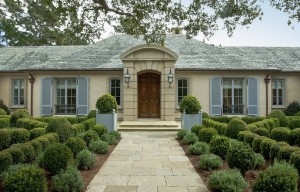 Inspired by estates of the French countryside of the 1600s, the French Provincial style home came to America after World War I, bringing with it decorative appeal and romantic touches.
Inspired by estates of the French countryside of the 1600s, the French Provincial style home came to America after World War I, bringing with it decorative appeal and romantic touches.
Yaple Park and Medlock Place Historic District are two neighborhoods you can find French Provincials.
Georgian Revival Architecture In Phoenix, Arizona (1883-1949)
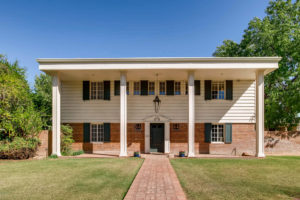 The Georgian style, with its long history in America, is among our country’s most consistently popular styles. Admired for its symmetrical design, classic proportions, and decorative elements, it is commonly associated with the reigns of England’s King Georges, I through III. However, there are a small handful in Phoenix, Arizona Historic Districts.
The Georgian style, with its long history in America, is among our country’s most consistently popular styles. Admired for its symmetrical design, classic proportions, and decorative elements, it is commonly associated with the reigns of England’s King Georges, I through III. However, there are a small handful in Phoenix, Arizona Historic Districts.
Mission Revivals Spanish Architecture in Phoenix, Arizona (1890-1935)
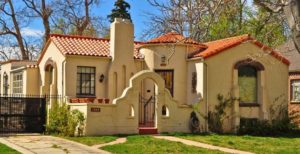 The Mission Revival home movement enjoyed its greatest popularity between 1890 and 1915 but continued evolving into the 1930s. The Spanish Mission Style and its associated Spanish Colonial Revival Style became internationally influential.
The Mission Revival home movement enjoyed its greatest popularity between 1890 and 1915 but continued evolving into the 1930s. The Spanish Mission Style and its associated Spanish Colonial Revival Style became internationally influential.
Many, Many historic districts in Phoenix have Spanish and Mission Revivals but a few are Alvarado, Cheery Lynn Historic District, FQ Story and La Hacienda Historic District.
Monterey Architecture in Phoenix, Arizona (1920-1960)
 The Monterey Style home was born in 19th century California, but its popularity expanded throughout a growing 20th century United States.
The Monterey Style home was born in 19th century California, but its popularity expanded throughout a growing 20th century United States.
In Phoenix, the Encanto-Palmcroft Historic District has some fine examples of Monterey’s.
Pueblo Revival Architecture in Phoenix (1912-present)
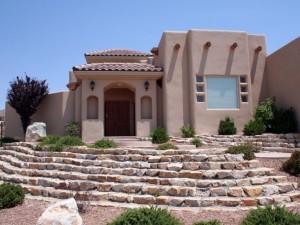 The flat roofs and earth-toned walls of the Pueblo style homes were inspired by the simple structures of the Pueblo Indians. This type of home, immensely popular in the Southwest, has deeper roots than almost any other type of American architecture. Pueblo homes are often made with Adobe construction.
The flat roofs and earth-toned walls of the Pueblo style homes were inspired by the simple structures of the Pueblo Indians. This type of home, immensely popular in the Southwest, has deeper roots than almost any other type of American architecture. Pueblo homes are often made with Adobe construction.
Spanish Influence
It developed in New Mexico and Arizona around the turn of the 20th century, borrowing from the simple, sleek multi-family structures erected by the Pueblo Indians starting in 750 A.D. Most modern versions of Pueblo architecture (also called Pueblo Revival) have a heavy Spanish influence. Arcadia Historic Neighborhood has some fine examples of rare Pueblo Revival homes.
Ranch Architecture, Old and Modern Style Architecture in Phoenix, Arizona (1930-1985)
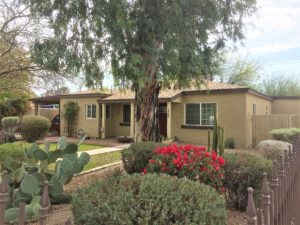 Low-slung Ranch style homes, modeled after the casual style of homes on true Western ranches were first built in the 1930’s and spent the next four decades popping up everywhere throughout the country. Phoenix has an abundance of ranch homes in many flavors from historic to modern.
Low-slung Ranch style homes, modeled after the casual style of homes on true Western ranches were first built in the 1930’s and spent the next four decades popping up everywhere throughout the country. Phoenix has an abundance of ranch homes in many flavors from historic to modern.
Spanish Colonial Architecture in Phoenix, Arizona (1890-1930)
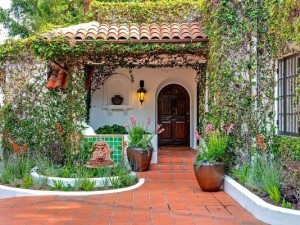 Settlers from the Mediterranean fused design from Europe & Native America with their own to create a variety of home styles.
Settlers from the Mediterranean fused design from Europe & Native America with their own to create a variety of home styles.
As a result, the Spanish Colonial Revival is used to describe homes built in the early 20th century. These incorporate various elements of Mediterranean architecture. But, as with all true styles, these homes are linked by a set of common physical characteristics.
Where to Buy a Spanish Style Home In Phoenix?
For a good look at Period Revival homes and other Spanish style homes in Phoenix, check out Los Olivos Historic District, Country Club Park, FQ Story, Encanto-Palmcroft and Willo, just to name a few.
Tudor Revival Architecture in Phoenix, Arizona (1890-1950)
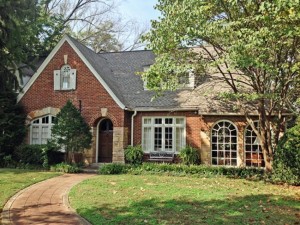 Originating in England, the Tudor Revival style home is one of the most recognizable home styles. Best known for steeply pitched, multi-gabled roofs and decorative half-timber framing, Tudors are mostly found in established neighborhoods. They were built during the first half of the 20th century.
Originating in England, the Tudor Revival style home is one of the most recognizable home styles. Best known for steeply pitched, multi-gabled roofs and decorative half-timber framing, Tudors are mostly found in established neighborhoods. They were built during the first half of the 20th century.
Where to Buy a Tudor Style Home In Phoenix?
In Phoenix, there are so many wonderful historic neighborhoods with Tudors of all kinds. A few neighborhoods you can check out for a roll back into time are FQ Story, Encanto-Palmcroft, Coronado, Fairview Place and Cheery Lynn. However, there are others as well.
Victorian & Queen Anne Architecture In Phoenix, Arizona (1830-1910)
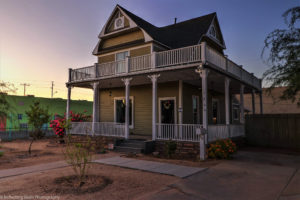 Victorian homes architecture emerged between 1830 and 1910 under the reign of Queen Victoria. These include sub-styles such as Gothic revival, Italianate, Second Empire, Queen Anne, stick style, Romanesque style and shingle style.
Victorian homes architecture emerged between 1830 and 1910 under the reign of Queen Victoria. These include sub-styles such as Gothic revival, Italianate, Second Empire, Queen Anne, stick style, Romanesque style and shingle style.
Victorian Homes are More Complex in Design
Constructed more for beauty than functionality, Victorian homes tend to be more complex in design. Features include ornate trim, bright colors, large porches, asymmetrical shape and multi-faceted roof-lines. Victorian-era homes in eastern American cities tend to be three stories. Those in western American cities tend to be two-story houses or one-story cottages.
